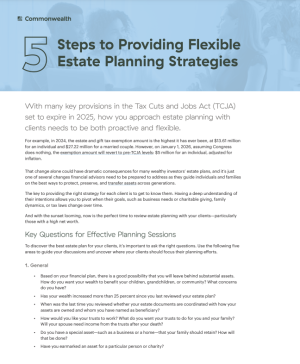Preserving Client Assets: How to Navigate Irrevocable Medicaid Trusts

Facing the prospect of long-term care can be daunting—not just emotionally but financially as well. With skyrocketing costs, your clients may fear depleting their hard-earned savings to qualify for Medicaid, the government program that covers long-term care expenses. But what if there was a way to protect their assets while still allowing them to access crucial care? One strategic tool many advisors use to achieve this is an irrevocable Medicaid trust.
To help advisors navigate the nuances of using a trust to protect client assets, let’s look at the basic structure of a trust and ways to direct client conversations around the benefits and drawbacks.
A Breakdown of the Irrevocable Medicaid Trust
Think of an irrevocable Medicaid trust as a legal agreement that holds onto client assets, typically their home and investments. The key here is irrevocable, which means that once a client transfers ownership to the trust, they can’t take it back.
This doesn’t mean that you—or your clients—necessarily need to be alarmed. While they won’t have control over their assets, they’ll designate a trusted individual (the trustee) to manage the assets according to the terms of the trust. More importantly, this transfer allows the assets to be excluded from Medicaid's asset limits, potentially opening the door to long-term care benefits, without jeopardizing their financial security.
Free Download: 5 Steps to Providing Flexible Estate Planning Strategies [Get Your Guide]
4 Key Questions to Drive the Client Conversation
While an irrevocable trust can be a powerful asset protection tool, there are a lot of client-specific priorities and circumstances to balance when assessing this approach. Ask your clients the following questions to help them decide if an irrevocable Medicaid trust is right for them.
1How will they use their assets prior to their death?
The family dynamic between the intended trust parties is the first consideration. Before entering an irrevocable arrangement, your client should be comfortable with how the assets will be used prior to their death. Neither your client nor their spouse can be a beneficiary of the trust principal.
This means the trustee has the right to use the trust assets for a named beneficiary during the donor's lifetime, even if it goes against their wishes. Therefore, your clients may want to avoid establishing an irrevocable trust unless they are confident that the named trustee and/or beneficiaries share their intentions for the trust assets.
To alleviate some of these concerns, trusts can usually be drafted to preserve the donor’s ability to occupy real property held in the trust for their lifetime and to allow the donor to change the beneficiaries who will inherit the trust property. In some states, clients can serve as their own trustee and be entitled to receive income from the trust.
These clients should consider whether being subject to the scrutiny associated with serving as trustee and having a right to income is in their best interest, as any income received would be forwarded to their nursing home should long-term care become necessary.
2What are the tax implications of funding the trust?
Clients often seek to protect investments and real property during Medicaid planning. Your clients must discuss tax considerations with the attorney drafting the trust to ensure that a comprehensive analysis has taken place. Here are a few tax-related questions to keep in mind:
Will the trust beneficiaries be subject to unnecessary capital gains tax obligations because contributions to the trust are deemed taxable gifts? If the irrevocable Medicaid trust is drafted for nursing home purposes and not to address estate tax concerns, contributions should not be countable for Medicaid purposes but would still be included in the donor’s gross estate. This would ensure that the trust assets receive a step-up in basis at the donor’s death, which can significantly reduce any capital gains tax owed.
Will the trust income be taxed at the donor’s rate or the trust’s rate? If drafted as a grantor trust, the trust’s income can be included on the donor’s tax return—without necessarily requiring income to be distributed to the donor.
Will they receive different care on Medicaid?
It’s important to realize that while the irrevocable Medicaid trust strategy is designed to preserve wealth, it anticipates that clients will make use of the government-sponsored Medicaid program to pay for a portion of their care. This may affect the choice of care for your client. While there are specific laws against patient discrimination based on source of payment, it’s a common fear that facilities have different accommodations for patients who pay with private funds versus those who use Medicaid.
4Is their portfolio heavily weighted with retirement accounts?
Clients often hit a stumbling block with irrevocable trusts when their portfolio is heavily weighted with retirement accounts. Qualified plan or IRA participants cannot transfer ownership of their accounts to a trust. This makes liquidating some or all of the accounts the only way to fund the trust. In this case, consider the following:
State implications. Your client will need to understand how their state views retirement accounts. Several states consider required minimum distributions as income but exempt the account. Other states count the institutionalized individual’s qualified account as an asset but exempt the spouse’s account when assessing Medicaid eligibility. Still, other states count the entire qualified account as an asset in a Medicaid eligibility assessment regardless of payout status.
Medical outlook. If your client has a pressing medical condition that could justify liquidation, will they need long-term care within the next five years? If yes, discuss with your clients whether a strategic multiyear withdrawal is more appropriate from a tax perspective. Clients should also consider whether the potential beneficiaries would receive the inherited assets during high-income-earning years; this would further justify a withdrawal for protection purposes, as the realization of income by an elderly individual, rather than younger beneficiaries, may result in less of an income tax hit.
Alternative strategies. Given the five-year “waiting period” that exists with an irrevocable Medicaid trust, consider other ways to protect the qualified accounts when the need arises. If the individual in need of long-term care has a healthy spouse, there may be complex strategies available to spend down or transfer assets in excess of the available exemptions when nursing home needs arise. For example, clients may be able to make a transfer to their healthy spouse and then purchase a single premium immediate annuity.
Tax deductions. The medical treatment aspect of a nursing home stay can be tax deductible. So, if assets are needed to cover long-term care costs, then retirement accounts are typically the preferred source of payment. This is because as the assets are withdrawn, generating a tax liability, the medical costs represent an offsetting deduction.
Guiding Your Clients’ Long-Term Planning Journey
Irrevocable Medicaid trusts are certainly not ideal for all clients. But by maintaining an understanding of their value and when their use is (or is not) appropriate, you can help ensure that your clients have the right plan in place to achieve their goals and preserve wealth for the next generation.

FREE DOWNLOAD
Estate Planning Made Easy
Protecting client wealth starts with a conversation. And with our comprehensive list of questions, you can help clients preserve their legacy and prepare for possible long-term care needs.
Commonwealth Financial Network® does not provide legal or tax advice. You should consult a legal or tax professional regarding your individual situation.
Editor’s note: This post was originally published in July 2018, but we’ve updated it to bring you more relevant and timely information.
This material is for educational purposes only and is not intended to provide specific advice.
Please review our Terms of Use.


